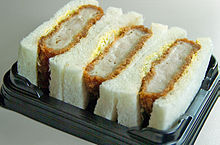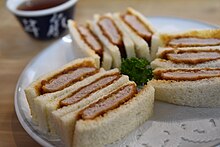Tonkatsu
You can help expand this article with text translated from the corresponding article in Japanese. (January 2020) Click [show] for important translation instructions.
|
 | |
| Place of origin | Japan |
|---|---|
| Region or state | East Asia |
| Main ingredients | Cutlet (pork fillet or loin), panko, cooking oil |
Tonkatsu (豚カツ, とんかつ or トンカツ, pronounced [toŋkatsɯ]; "pork cutlet") is a Japanese dish that consists of a breaded, deep-fried pork cutlet. It involves coating slices of pork with panko (bread crumbs), and then frying them in oil. The two main types are fillet and loin. Tonkatsu is also the basis of other dishes such as katsukarē and katsudon.
Etymology
[edit]The word tonkatsu is a combination of the Sino-Japanese word ton (豚) meaning "pig", and katsu (カツ), which is a shortened form of katsuretsu (カツレツ),[1] an old transliteration of the English word "cutlet",[2][3] which was in turn adopted from the French word côtelette.[4]
History
[edit]Tonkatsu originated in Japan during the Meiji Era in the late 19th century, a dish derived from a French dish known as côtelette de veau, a veal cutlet coated in breadcrumbs and fried in a pan with butter.[5]
European katsuretsu (loanword/gairaigo for cutlet) was usually made with beef; the pork version was created in 1899 at a restaurant serving European-style foods named Rengatei in Tokyo, Japan.[6][7][8] It's a type of yōshoku—Japanese versions of European cuisine invented in the late 19th and early 20th centuries—and was called katsuretsu or simply katsu.[9]
Preparation and serving
[edit]
Either a pork fillet (ヒレ, hire) or pork loin (ロース, rōsu) cut may be used; the meat is usually salted, peppered, dredged lightly in flour, dipped into beaten egg and then coated with panko (bread crumbs) before being deep fried.[10]
Tonkatsu is then sliced into bits and served, commonly with shredded cabbage.[10][11] It is most commonly eaten with a thick Worcestershire-style sauce called tonkatsu sauce[10] or simply sōsu (sauce), karashi (mustard), and perhaps a slice of lemon. It is usually served with rice, miso soup and tsukemono and eaten with chopsticks. It may also be served with ponzu and grated daikon instead of tonkatsu sauce.[12]
Variations
[edit]


Tonkatsu is also popular as katsukarē served on Japanese curry, or as katsudon, simmered with egg and broth, then served on a big bowl of rice; there is also katsu rice, which is pork cutlet served on rice topped with demi-glace sauce. Another popular variation, katsu-sando or pork cutlet sandwich, is said to be originated from the Isen, a tonkatsu restaurant. In the 1930s, the manager of the Isen came up with the concept, then improved it by making the sandwich smaller so that its clientele of local geishas could enjoy it without wearing off their lipstick.[13]
In Nagoya and surrounding areas, miso katsu, tonkatsu eaten with a hatchō miso-based sauce, is a speciality.[14]
Variations on tonkatsu may be made by sandwiching an ingredient such as cheese or shiso leaf between the meat, and then breading and frying.
Variations of katsu other than pork:
- Chicken katsu (チキンカツ) or tori katsu (鶏カツ), which uses chicken instead, often appears in Hawaiian plate lunches.
- Menchi-katsu (メンチカツ) or minchi katsu (ミンチカツ mince katsu), is a minced meat patty, breaded and deep fried.
- Hamu katsu (ハムカツ ham katsu), a similar dish made from ham, is usually considered a budget alternative to tonkatsu.
- Gyū katsu (牛カツ beef katsu), also known as bīfu katsu, is popular in the Kansai region around Osaka and Kobe.
In general, breaded and deep-fried foods are called furai ("fry"),[15] such as ebi-furai (fried prawn)[15] and aji-furai (fried horse mackerel), but fried meat such as pork, beef and chicken is referred to as katsu (cutlet).[2] Katsu and furai differ from tempura, which is not breaded[16] and typically fried in sesame oil.
In recent years, chicken katsu curry has become extremely popular in the United Kingdom,[17] to the point that other varieties of Japanese curry and curry sauce are sometimes referred to as katsu erroneously.[18]

See also
[edit]![]() Media related to Tonkatsu at Wikimedia Commons
Media related to Tonkatsu at Wikimedia Commons
![]() Tonkatsu at the Wikibooks Cookbook subproject
Tonkatsu at the Wikibooks Cookbook subproject
- Japanese cuisine
- List of Japanese dishes – a category of deep-fried dishes in Japanese cuisine
- List of pork dishes
- Milanesa
- Schnitzel
- Dongaseu – a Korean dish derived from tonkatsu
- Escalope
References
[edit]- ^ "Tonkatsu" 豚カツ. Nihon Kokugo Daijiten Concise edition, web version (精選版 日本国語大辞典) (in Japanese). Shogakukan. Retrieved 2023-10-22 – via kotobank.jp. ["katsu" is a contraction of カツレツ ("katsuretsu").]
- ^ a b "Katsuretsu" カツレツ [cutlet]. Nihon Kokugo Daijiten Concise edition, web version (精選版 日本国語大辞典) (in Japanese). Shogakukan. Retrieved 2021-08-16 – via kotobank.jp. [cutlet [... shortened form is] "katsu".]
- ^ "katsuretsu" カツレツ. 新修百科大辭典 (in Japanese). Tokyo, Japan: Hakubunkan. 1934-04-14 [1934-04-05]. p262 row 4 – via Google Books. [From English word "Cutlet" (sliced meat), [...]. Also shortened to カツ ("katsu").]
- ^ "Cutlet". OED. Vol. 2 C (1 Corrected re-issue ed.). Oxford, UK: The Clarendon Press. 1933. p. 1293 – via Internet Archive.
- ^ "The Roots of Tonkatsu: A Delicious Fusion of East and West | October 2018 | Highlighting Japan". www.gov-online.go.jp. Retrieved 2023-10-22.
- ^ 岡田, 哲. とんかつの誕生―明治洋食事始め. p. 166.
- ^ 小菅, 桂子. にっぽん洋食物語大全. p. 122.
- ^ Kaneko, Amy (2007). Let's Cook Japanese Food!: Everyday Recipes for Home Cooking. Chronicle Books. p. 101. ISBN 978-0-8118-4832-9.
- ^ Jennifer Ellen Robertson, ed. (2005). A companion to the anthropology of Japan. Wiley-Blackwell. p. 421. ISBN 0-631-22955-8.
- ^ a b c Tsuji, Shizuo; Fisher, M. F. K. (2007). Japanese Cooking: A Simple Art. Kodansha International. p. 240. ISBN 978-4-7700-3049-8.
- ^ Hosking, Richard (1995). A Dictionary of Japanese Food: Ingredients and Culture. Tuttle. p. 159. ISBN 0-8048-2042-2.
- ^ Ono, Tadashi; Salat, Harris (2013). Japanese Soul Cooking: Ramen, Tonkatsu, Tempura, and More from the Streets and Kitchens of Tokyo and Beyond. Potter/Ten Speed/Harmony/Rodale. ISBN 9781607743538. Retrieved 21 July 2020.
- ^ Oba, Yumi (2022-09-28). "From geishas to the world: Katsu sando, then and now". SBS Food. Australia. Archived from the original on 2023-11-01. Retrieved 2023-12-09.
- ^ "名古屋国際センター | Nagoya International Center". Archived from the original on 2019-06-10. Retrieved 2013-01-02.
- ^ a b "Furai (ryouri)" フライ (料理) [Fry (cooking)]. Encyclopedia Nipponica web version (in Japanese) (constantly updated ed.). Shogakukan. Retrieved 2021-08-16 – via kotobank.jp.
(rough translation): In Western cuisine, "frying" means to deep-fry or sautee in oils or fats. [...] In Japan, "furai" refers to foods that are dipped in wheat flour, beaten egg, bread crumbs and then deep-fried, [...]. If the ingredient is meat, it is called "chikin katsuretsu", "pōku katsuretsu (tonkatsu)" etc., respectively.[...]
- ^ No panko appears in definition of tempura: "Tempura" 天麩羅 テンプラ. Digital Daijisen (デジタル大辞泉) (in Japanese) (constantly updated ed.). Shogakukan. Retrieved 2021-08-16 – via kotobank.jp.
(rough translation): 1.[...ingredients] dipped in batter made of wheat flour, egg and water, then fried in vegetable oil. Vegetable tempuras are sometimes distinguished and called "shōjin-age". [...]
- ^ Hargreaves, Clare (2019-10-09). "Forget tikka masala - chicken katsu is the new true British national dish". inews.co.uk. Retrieved 2023-08-08.
- ^ "The U.K. thinks Japanese curry is katsu curry, and people aren't happy about it". SoraNews24 -Japan News-. 2020-02-12. Retrieved 2023-08-08.
